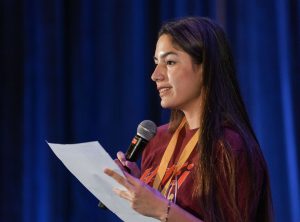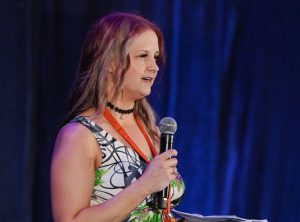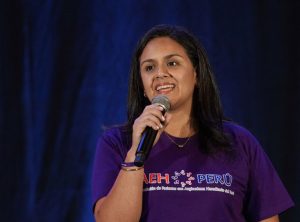This article is part of an extensive feature on the 2024 HAEi Regional Conference Americas, published in Global Perspectives #1 2024
Patient Voices – In Our Own Words
The audience then heard from three courageous women intent on telling their personal stories to inspire and educate their peers. All three gave powerful speeches that resonated with all in the audience, who showed their appreciation with prolonged applause for every speaker.
 Taira Corrales Gonzalez , Costa Rica
Taira Corrales Gonzalez , Costa Rica
I am 16 years old, and I am from Costa Rica.
Today, I want to tell my story and how I have managed, along with my family, to cope with this disease.
The first person to be diagnosed in my family was my grandfather. His name was Gerardo Gonzalez Medina. He was diagnosed at the age of 60 and passed away from angioedema four years ago. Years ago, in Costa Rica, the knowledge of HAE was scarce. For this reason, I can say that my grandfather’s death occurred because the doctors did not have the correct knowledge to treat him. Today, approximately 70 patients around Costa Rica have this disease. Costa Rica is still working on a law to protect us as patients of a rare disease.
My C1 and C4 tests were performed in a private medical center since the Costa Rican Social Security Fund did not perform such tests. I was the first person to receive a genetic test at the Children’s Hospital. Patients with HAE only had danazol or fresh frozen plasma, which caused me a skin allergy. Costa Rica has evolved in treatment, and although there are areas for improvement, today, we have two drugs for HAE. Last Friday, I received -with much love and happiness- the first dose of icatibant to administer at home.
It is worth mentioning that the registration of the medicines took about seven years of constant effort. In the case of Costa Rica, a lawyer donated his time and his ability to write letters with his signature. It was impossible to work with the government without it. Achieving the medicine registration would not have been possible without his help.
I was diagnosed by Dr. Mario Martinez, a specialist in Allergology at Hospital Mexico. He was the one who diagnosed my whole family. My family has been misdiagnosed multiple times. My uncle and my mother had surgery, as the doctors thought it was appendicitis.
Seeing that Costa Rica has improved over time fills my soul with strength and peace. I remember I spent most Christmases in the hospital. It reminds me of the little arguments my mom had with the doctors because they did not understand what it meant to have HAE. As a family, we have been able to deal with the different situations that arise from having this disease.
My family lives in constant fear that my grandfather’s story will repeat itself. This year, I decided to take action and get more involved in Costa Rica. I took charge of the HAE patient group. It is impressive to see how much impact the patient community has.
I hope that Costa Rica can organize itself further in the future. I hope not to have to go to the hospital so often. I hope to be able to spend Christmas as a family. I hope that my family can be more united to understand what it means to suffer from HAE. I hope that awareness of this disease will spread and more people around the world will know about it. Finally, I hope my story has touched your heart.
 Anne Warren, Canada
Anne Warren, Canada
I’m 39 years old, and I’m from Canada. I have HAE type 1. I was diagnosed at the age of 12, but started suffering with attacks at the age of 3 to 4 years old.
At the age of three years old, I remember being sick and telling my mother, why am I here? I knew that my siblings and I experienced sickness differently. I knew I was the odd one out. Now, I’d go back to my 3-year-old self and say knowledge is power, and to educate myself.
When I was younger, there were no treatments. There were no outreach groups. There was nothing for me to relate to and nobody to speak about my disease. So, I fought for years to try to have a diagnosis.
Having the advocacy group HAE Canada helped me enormously. It was one of the leading factors of my advocating for HAE in my community.
When I was younger, attacks were mostly in my face. When I became a teenager, they went to my abdomen, feet, and hands.
A year ago, I saw a fatal accident while working as a coach driver. I had to be the first responder, and it ended up causing throat swells when previously I had none. I know that mental health and stress play a big role in HAE. You have to know yourself. You have to make sure that your mental health is good.
My grandfather passed away with HAE when he was 42 years old. When I was diagnosed at 12, I was told that I wouldn’t live a day past my 40s. I’m about to be 40 this year, and I cannot wait to go see the doctor and tell him that he was wrong.
Looking back on my treatments, they would often treat me with antihistamines, anti-inflammatories, and steroids. All did nothing. When I was in my 20s, I finally had the treatments that I needed, and now, in my 30s, I get the preventative treatments, which are a lot better.
Traveling was a no-go for me before. I was not able to go more than 100 kilometers away from my home. Now, I’m able to travel worldwide. It’s amazing to be here. Even at the airport in Colombia, I was going to be denied boarding because I was starting to have a throat swell. I had to inform the stewardess that I had my treatments; I was able to administer them, and I would be okay. I got upgraded to first-class because they were trying to say that I was not fit to travel, but I proved them wrong. I was able to travel.
One of the things that HAE Canada helped me with is to act. Social media helped me too. I know that one of my triggers is emotional. If I’m stressed it will definitely cause triggers. I was told that rashes or bruising weren’t a part or a symptom of HAE. I have realized that every time I get a bruise, within a day, I will have a swell. Now, I infuse right away.
It makes me very happy to know that more people are listening to my journey. It will help other patients to get better treatment, so don’t give up. I encourage everyone to participate in research. I’ve participated in many clinical trials.
I used to go through attacks on an almost daily basis. Now I’m getting them once or twice a week.
I keep fighting. I fight for my medication. I fight my disease. It will always live inside me. Even with a disease, you can move on and go forward.
 Claudia Rafael, Peru
Claudia Rafael, Peru
Eight years ago, one night I was about to go to sleep. It was late, and I received a WhatsApp message.
It was my sister Vanessa. She said to me: ‘Claudia, you have this?’ She sent me a link, which I followed. It had a lot of information about HAE. I immediately saw myself in all the information. After a bit, I realized that I had a rare disease that had no medication in my country and no cure. I fell asleep, crying then not crying, and thinking about my daughter, who was only 4 years old.
The next morning, I had two choices. My first option was to continue in denial and ask: Why is this happening to me? The second option I had was to accept what had come into my life and that it was going to stay. I returned to the information I had on the web and contacted Dr. Oscar Calderon. He graciously helped me, not only with the diagnosis. Dr. Calderon introduced me to a small group of patients. I think we were 5 or 6 patients at that time.
After getting around some barriers, we formalized and founded HAE Peru. We knew what we wanted. We wanted to work for a better quality of life for patients, which was so lacking in Peru. And so we did. In some cases, formalizing an organization tends to be long and complex. We did it in record time. When we drew up the first work plan, it lasted six months. The second work plan was for one year. It was really comforting, not only for me but also for my colleagues, seeing how little by little we were carrying out each of the projects we had proposed.
The following year, in 2018, a medicine was registered in Peru. I asked my insurance company for coverage of this medicine. You know what happened. I was denied. But the insurance company did not count on something. I was going to review my policy. I did, and I found a little paragraph whose interpretation favored me. Also, the insurance company didn’t count on the fact that Dr. Calderon had instructed me on the entire medical report that he had prepared for the insurance company, explaining and substantiating why I needed the medication in a vital way.
I left that meeting with a lot of sunshine—happy. I was sure that the answer I would get would be positive—and I got the positive answer! I believe I am the first patient in Peru to receive a drug covered by insurance in an amount higher than 80%.
I shared this process of having the medicine provided through private insurance with all the patients of the Association. Many obtained the medicine, others, unfortunately, did not have the same success.
It is here that all of us in HAE do not stop when we do not get the medicine. This is the moment when we have to persevere the most. We have learned that we have the right to health, and we have to be informed to be able to complain.
We have been working on the project of a story, told by adults for children. We are working with teachers and book editors on this, but the pandemic made funding difficult. We raised money to print 100 books and worked for 3 months to make it a reality. By the end of 2021, we got funding to make a video version and have the money for 500 books. It is now on sale, and all the proceeds will help us help even more people with HAE. The story also means we can take HAE into schools and build a truly inclusive society.
HAE Peru awakened my 17-year-old self, a law student, who today, at 44 years of age, can do a little more. We continue to work together in HAE Peru, in collaboration with Dr. Calderón and Milagros Cordoba. I am grateful for the opportunity, and I know that if there is something useful for any association, they will take it.










